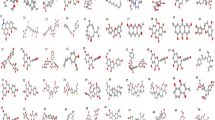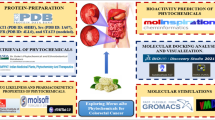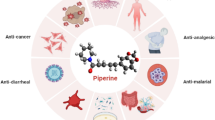Abstract
Carbonic anhydrase II (CA II) is an important enzyme complex with Zn2+, which is involved in many physiological and pathological processes, such as calcification, glaucoma and tumorigenicity. In order to search for novel inhibitors of CA II, inhibition assay of carbonic anhydrase II was performed, by which seven natural phenolic compounds, including four phenolics (grifolin, 4-O-methyl-grifolic acid, grifolic acid, and isovanillic acid) and three flavones (eriodictyol, quercetin and puerin A), showed inhibitory activities against CA II with IC50s in the range of 6.37–71.73 μmol/L. Grifolic acid is the most active one with IC50 of 6.37 μmol/L. These seven phenolic compounds were proved to be novel natural carbonic anhydrase II inhibitors, which were obtained in flexible docking study with GOLD 3.0 software. Results indicated that the aliphatic chain and polar groups of hydroxyl and carboxyl are important to their inhibitory activities, providing a new insight into study on CA II potent inhibitors.
Similar content being viewed by others
References
Scozzafava A, Mastrolorenzo A, Supuran C T. Carbonic anhydrase inhibitors and activators and their use in therapy. Expert Opin Ther Patents, 2006, 16 (12): 1627–1664
Nishimori I, Innocenti A, Vullo D, Scozzafava A, Supuran C T. Carbonic anhydrase inhibitors. Inhibition studies of the human secretory isoform VI with anions. Bioorg Med Chem Lett, 2007, 17 (4): 1037–1042
Zeng G Z, Huang H Q, Tan N H, Ji C J, Pan X L. Carbonic anhydrase II: Structures, functions and inhibitors. Acta Botanica Yunnanica, 2006, 28 (5): 543–552
Supuran C T, Scozzafava A, Casini A. Carbonic anhydrase inhibitors. Med Res Rev, 2003, 23 (2): 146–189
Jackman J E, Merz K M, Fierke C A. Disruption of the active site solvent network in carbonic anhydrase II decreases the efficiency of proton transfer. Biochemistry, 1996, 35 (51): 16421–16428
Scolnick L R, Clements A M, Liao J, Crenshaw L, Hellberg M, May J, Dean T R, Christianson D W. Novel binding mode of hydroxamate inhibitors to human carbonic anhydrase II. J Am Chem Soc, 1997, 119 (4): 850–851
Vicker N, Ho Y, Robinson J, Woo L L W, Purohit A, Reed M J, Potter B V L. Docking studies of sulphamate inhibitors of estrone sulphatase in human carbonic anhydrase II. Bioorg Med Chem Lett, 2003, 13 (5): 863–865
Rousselle A V, Heymann D. Osteoclastic acidification pathways during bone resorption. Bone, 2002, 30 (4): 533–540
Fiore A D, Scozzafava A, Winum J Y, Montero J L, Pedone C, Supuran C T, Simone G D. Carbonic anhydrase inhibitors: Binding of an antiglaucoma glycosyl-sulfanilamide derivative to human isoform II and its consequences for the drug design of enzyme inhibitors incorporating sugar moieties. Bioorg Med Chem Lett, 2007, 17 (6): 1726–1731
Maren T H, Conroy C W. A new class of carbonic anhydrase inhibitor. J Biol Chem, 1993, 268 (35): 26233–26239
Fu X, Tan N H, Jiang L H, Jia R R, Ji C J, Landro J, Fekete A, Mueller H, Henkel T. Searching for antiosteoporotic activities of extracts and fractions derived from natural sources targeting carbonic anhydrase II. Acta Botanica Yunnanica, 2003, 25 (6): 724–729
Huang H Q, Pan X L, Tan N H, Zeng G Z, Ji C J. 3D-QSAR study of sulfornamide inhibitors of human carbonic anhydrase II. Eur J Med Chem, 2007, 42 (3): 365–372
Verdonk M L, Cole J C, Hartshorn M J, Murray C W, Taylor R D. Improved protein-ligand docking using GOLD. Proteins, 2003, 52 (4): 609–623
Ding Z H, Dong Z J, Liu J K. Albaconol, a novel prenylated resorcinol (= Benzene-1,3-diol) from basidiomycetes Albatrllus confluens. Helv Chim Acta, 2001, 84 (1): 259–262
Ishii N, Takahashi A, Kusano G, Nozoe S. Studies on the constituents of Polyporus dispansus and P. confluens. Chem Pharm Bull, 1988, 36 (8): 2918–2924.
Xie J B, Li P. Studies on phenolic acid from Ilex purpurea Hassk. J China Pharmaceut Univ, 2002, 33 (1): 76–77
Pan J Y, Zhang S, Yan L S, Tai J D, Xiao Q, Zou K, Zhou Y, Wu J. Separation of flavanone enantiomers and flavanone glucoside diastereomers from Balanophora involucrate Hook. f. by capillary electrophoresis and reversed-phase high-performance liquid chromatography on a C18 column. J Chromatogr A, 2008, 1185 (1): 117–129
Xu J F, Tan N H. Studies on the chemical constituents from the branches and leaves of Cupressus duclouxiana. J Chin Med Materials, 2007, 30 (6): 669–671
Zhou Z H, Zhang Y J, Xu M, Yang C R. Puerins A and B, two new 8-C substituted flavan-3-ols from Pu-er tea. J Agric Food Chem, 2005, 53 (22): 8614–8617
Jones G, Wilett P, Glen R C, Leach A R, Taylor R. Development and validation of a genetic algorithm for flexible docking. J Mol Biol, 1997, 267 (3): 727–748
Tuccinardi T, Nuti E, Ortore G, Supuran C T, Rossello A, Martinelli A. Analysis of human carbonic anhydrase II: Docking reliability and receptor-based 3D-QSAR study. J Chem Inf Model, 2007, 47 (2): 515–525
Hu X, Balaz S, Shelver W H. A practical approach to docking of zinc metalloproteinase inhibitors. J Mol Graph Model, 2004, 22 (2): 293–307
Wallace A C, Laskowski R A, Thornton J M. LIGPLOT: A program to generate schematic diagrams of protein-ligand interactions. Protein Eng, 1995, 8 (2): 127–134
Author information
Authors and Affiliations
Corresponding author
Additional information
Authors with the equal contribution
Supported by the National Natural Science Foundation of China (Grant No. 30725048) and the Foundation of Chinese Academy of Sciences (West Light Program).
Rights and permissions
About this article
Cite this article
Huang, H., Pan, X., Ji, C. et al. Screening and docking studies of natural phenolic inhibitors of carbonic anhydrase II. Sci. China Ser. B-Chem. 52, 332–337 (2009). https://doi.org/10.1007/s11426-008-0133-1
Received:
Accepted:
Published:
Issue Date:
DOI: https://doi.org/10.1007/s11426-008-0133-1




